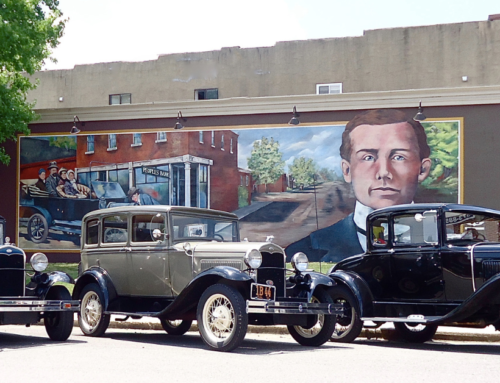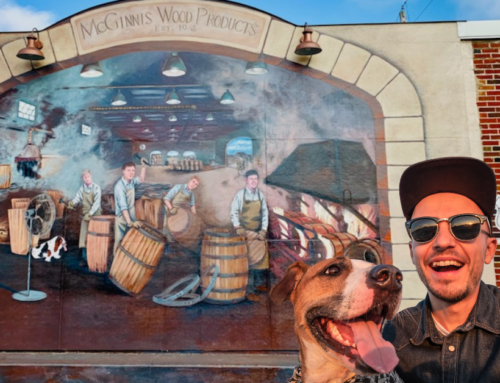
Bette Davis Visits Cuba
501 E Washington
Cuba MO
Viva Cuba’s 11th mural painted by the artist Ray Harvey on the Cuba Free Press highlights Bette Davis, one of the first ladies of American movies. It portrays a local story involving elements of drama and a touch of humor.
On November 2, 1948 the path of Bette Davis, her husband William Sherry, and local photographer Wilbur Vaughn were about to intersect at the Southern Hotel in a story that has become local legend. The event was originally recorded in the Cuba News and Review on November 4, 1948.
The Southern Hotel, now an apartment building, still sits between Route 66 and the railroad tracks. It is just across the street from the Cuba Free Press building. In 1948, it was a thriving business that provided travelers a room and a good meal. It was for one of these meals that Bette Davis and her husband stopped their 1948 Packard station wagon.
Movie star Bette Davis was eventually nominated for eight Academy Awards and won the award twice. The star, with her distinctive looks, was one of the most well-known faces in the world. Her movie June Bride was soon to open in movie theaters around the country. Her appearance in Cuba on a rainy evening created quite a stir.
On a recent Sunday afternoon, Wilbur Vaughn and his wife Imogene, who live outside Cuba, recalled the events of that cold, wet November evening in 1948. He was only nineteen years old, but he managed the local movie theater, did some photography from a darkroom set up in a closet of the theater, and from time-to-time filled in at the local paper, The Cuba News and Review. This quiet Monday evening would turn in to one that would provide Vaughn a story to tell for years to come.
“Rowena Wood at the Southern Hotel called me and said Bette Davis was in town,” Vaughn recalls. The nineteen-year-old Vaughn didn’t waste anytime getting to the hotel, but the couple was already seated at the table when Vaughn arrived. Vaughn says, “I asked her ‘Miss Davis, can I take your picture?’”
“Absolutely not,” replied her husband.
Well, I wanted to take it inside the restaurant anyway because it was so cold and wet outside, and I didn’t want to hang around outside waiting, but Mrs. Woods didn’t want me to take it inside the restaurant.” As a result, Vaughn was doomed to a cold wait outside.
According to the original story, Miss Davis ate not one, but two turkey dinners while she was inside the Southern Hotel. Mrs. Wood also said that she smoked the whole time. Mrs. Wood’s daughter Glenna served Miss Davis and was given an autograph by the star before she left the restaurant.
Not wanting to miss a chance to take the star’s photo, Vaughn snapped a photo outside on the porch as they left.
Well that’s when the excitement really started. Miss Davis’s irate husband started cursing. “He said he was going to kill me,” recalls Vaughn. “I took off running because I didn’t want to him to break my camera.” Then the race was on. With a 20-foot head start and chased by Sherry, Vaughn led the race between Hoyt’s Tavern and Wilmesherr’s Store. Then he crossed a lot behind the Shell station, still chased by Sherry.
According to the original newspaper account, “I didn’t look back once,” said Vaughn, “until I heard a dull, sticky thud behind me. Then I turned around and saw this guy flat on his face in the mud. I had jumped over the pile of the tires in back of Joe’s station, but he tried to plow through it. I didn’t have another flash bulb, or I could have had a real picture that time.”
Vaughn continued running in front of Cuba Drug and Ruthy and Wally’s Restaurant. Then he went behind the building, hid his camera so that Sherry couldn’t grab it, and entered the theater, where he had his darkroom set up in a small closet. Later, when he saw his pursuer pass the building, he retrieved the camera and developed the photo. He was standing by the door drying the photo when he saw Sherry go by again, still looking for him. “Bernie Williams [now Stubblefield] was the cashier at the theater back then, and she was kind of scared because this guy kept walking up and down the street in front of the theater.”
The photo and account of the chase appeared in that week’s paper. “Dewey and Truman were in the headline,” recalls Mrs. Vaughn, who was still in high school and dating Vaughn, her future husband at the time. They would be married the next year.
You would think that this would be the end of the story, but Miss Davis’ husband was in town the next day trying to find Vaughn. When he couldn’t find him, he told the gas station owner to have him call him at the Bird’s Nest Lodge.
“I called the lodge and asked if they had a Miss Davis or Mr. Sherry registered, but they said they didn’t. I figured they registered under another name.”
“I hung the picture in the theater. I don’t remember it, but my wife says I printed copies and sold them for a quarter a piece. But I don’t remember that,” says Vaughn. Mrs. Vaughn smiles and shakes her head yes. It sounds like a likely action for an ambitious, innovative young man, who could hold down three jobs and run foot races through the streets of Cuba in the evening.
But the saga still wasn’t over. “About six month’s later a guy came by the theater and said that he was from Hollywood. He said he had heard about the photo on Hedda Hopper’s Hollywood. I asked him if he wanted a copy, and he said yes.” Hopper was a gossip columnist of the time, who dealt with the activities of celebrities.
Vaughn would go on to serve as a photographer in the military in the early 50s. Later, he went from managing a theater to owning one. Today he is retired, and he and Mrs. Vaughn volunteer at the history museum, and they are glad to reminisce about the events on that fateful November night.
Davis, whose first movie was in 1931, acted until the end of her life. In the early 80s singer Kim Carnes had a hit song with the recurring refrain “She’s got Bette Davis eyes.” The actress sent the singer a thank you note because she had made the older actress seem contemporary to her grandson.
Having made over 100 movies, the actress died in 1989 from complications of cancer and a stroke. She was a liberated and independent woman with a desire to have things her own way and changed the way that women were looked at in the movie industry. In the 30s, when she was not satisfied with the work given to her by Warner Brothers Studio, which had her under contract, she fled to England to make movies. Although she was forced to come back to the US and honor her contract, she was offered much better movie roles as a result.
To use her own words, she said, “I have been uncompromising, peppery, intractable, monomaniacal, tactless, volatile, and often times disagreeable…I suppose I’m larger that life.” Cruise by Viva Cuba’s latest mural, and you will definitely find her—still larger than life.
Missouri artist Ray Harvey lives in the Washington, Missouri area. Harvey has an Associates Degree in Graphics and Technical Illustration. After working at Maritz, Inc. in St. Louis, he branched into freelance work. Since 1984, he has worked on an array of projects including commissions for the Chase Park Plaza, St. Albans Country Club, Merrill-Lynch, Bellerive Country Club, the Gateway Arch Museum, and many others. Harvey says, “I am optimistic about public art, and I would like to see these paintings be as common as billboards.” For more information on the artist, visit rayharveyart.com.






